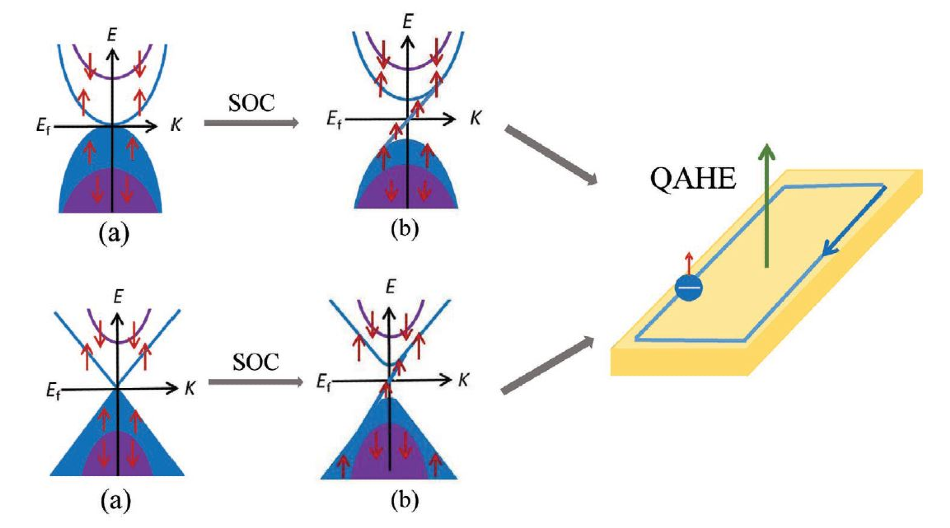Jun 29 2020
A team of researchers from the University of Wollongong has reported an extensive review of spin-gapless semiconductors (SGSs).
 The band structures of parabolic and Dirac type SGS materials with spin-orbital coupling, which leads to the quantum anomalous Hall effect. Image Credit: FLEET.
The band structures of parabolic and Dirac type SGS materials with spin-orbital coupling, which leads to the quantum anomalous Hall effect. Image Credit: FLEET.
SGSs are a new family of zero-bandgap materials containing electrons and holes that are fully spin-polarized.
The study strengthens the quest for materials that would enable ultra-fast, ultra-low-energy “spintronic” electronics without any wastage of dissipated energy from electrical conduction.
The properties of SGS materials are governed by their “bandgap”—the gap between the conduction and valence bands in the material—which defines their electronic properties.
Normally, one of the spin channels (i.e., one of the spin directions, up or down) tends to exhibit semiconducting behavior with a finite bandgap, whereas the other spin channel exhibits a closed (zero) bandgap.
In the case of a spin-gapless semiconductor (SGS), the edges of the valence and conduction bands touch in one spin channel, and the need for threshold energy to move electrons from occupied (valence) states to empty (conduction) states is avoided.
Due to this property, these materials tend to exhibit exclusive properties—their band structures are highly sensitive to external influences such as magnetic or field pressure.
A majority of the SGS materials tend to be ferromagnetic with high Curie temperatures.
Two types of energy-momentum dispersions can be found in the band structures of the SGSs—parabolic dispersion or linear (Dirac) dispersion.
The new study analyzes both the three sub-types of parabolic SGSs and the Dirac-type SGSs in various material systems.
The mobility of electrons in Dirac-type SGSs is two to four orders of magnitude greater when compared to that of classical semiconductors. Electrons in an SGS can be excited using very little energy, and their charge concentrations can be “tuned” very easily. For instance, this can be achieved by the introduction of a new element (doping) or by applying a magnetic or electric field (gating).
The Dirac-type SGSs feature fully spin-polarized Dirac cones and provide a platform for low-energy-consumption electronics and spintronics through dissipationless edge states induced by the quantum anomalous Hall effect.
Potential applications of SGSs in next-generation spintronic devices are outlined, along with low- electronics, and optoelectronics with high speed and low energy consumption.
Xiaolin Wang, Professor and Director, Institute for Superconducting and Electronic Materials, University of Wollongong
Wang is also the theme leader of FLEET.
In 2008, Professor Xiaolin Wang was the first to hypothesize SGSs, and since then, there have been worldwide efforts to discover suitable candidate materials, with a specific focus on Dirac-type SGSs.
In the last 10 years, researchers have predicted a large number of parabolic-type or Dirac-type SGSs using density functional theory, and certain parabolic SGSs have even been experimentally demonstrated in both bulk and monolayer materials.
Journal Reference:
Yue, Z., et al. (2020) Spin‐Gapless Semiconductors. Small. doi.org/10.1002/smll.201905155.